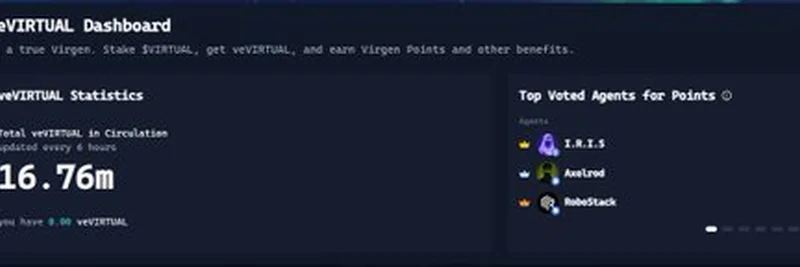Virtuals Protocol has made a significant move in the meme token space by introducing a CRV-style points voting system, known as veVIRTUAL Voted Agent Points (VVAP). This innovative approach allows veVIRTUAL holders, essentially those who stake $VIRTUAL tokens, to influence the distribution of 10% of the daily point supply across various active agents within the protocol. This development not only enhances the utility of Virtual staking but also deepens community engagement in the ecosystem.
Understanding the CRV-Style Points Voting
The CRV-style points voting system is inspired by Curve Finance's model, where token holders can vote on the allocation of rewards or points. In the case of Virtuals Protocol, this means that stakers can now direct a portion of the daily points to their preferred agents. This system is particularly exciting because it introduces a layer of governance and decision-making power to the holders, making the staking process more dynamic and interactive.
How It Works
- Staking $VIRTUAL Tokens: Holders stake their $VIRTUAL tokens to become veVIRTUAL holders.
- Voting Power: The amount of voting power is determined by the number of tokens staked.
- Point Distribution: 10% of the daily point supply is allocated based on the votes cast by veVIRTUAL holders.
This system ensures that the most valuable or preferred agents receive a larger share of the points, which can be crucial for their development and success within the protocol.
Impact on the Meme Token Ecosystem
The introduction of VVAP has several implications for the meme token ecosystem:
Enhanced Utility for Virtual Stakers
For those who hold and stake $VIRTUAL tokens, this new system provides a tangible benefit beyond mere holding. The ability to influence the protocol's direction and reward distribution adds a layer of utility that can attract more stakers and increase the token's value.
Community Engagement
By allowing community members to vote, Virtuals Protocol fosters a sense of ownership and involvement. This can lead to a more engaged and active community, which is vital for the long-term success of any blockchain project.
Focus on Genesis Tokens
The tweet highlights that most points have gone to the largest bags of Virtual stakers, particularly those holding the most valuable Genesis tokens. This is because the utility of Virtual staking includes access to Genesis deals and airdrops, making these tokens highly sought after. The voting system amplifies this trend, as holders of these tokens can leverage their staking power to secure more points for their preferred agents.
Outliers and Whales
Interestingly, there are a few outliers in the voting results, driven by some of the $VIRTUAL whales. These whales, who are either the devs or advisors of certain projects, have used their significant staking power to direct points towards their own agents. This behavior is not uncommon in decentralized finance (DeFi) projects, where large holders can influence outcomes due to their substantial voting power.
The Bigger Picture
Virtuals Protocol's move to introduce CRV-style points voting is a step towards greater decentralization and community-driven governance. It aligns with the broader trends in the DeFi space, where projects are increasingly looking to involve their communities in decision-making processes. This not only enhances the protocol's resilience but also its appeal to potential investors and users.
For those interested in diving deeper into Virtuals Protocol and its innovations, you can explore more at Virtuals Protocol's official website. Additionally, keep an eye on Meme Insider for the latest updates and analyses on meme tokens and blockchain technology.
This development is a testament to the evolving nature of meme tokens, transforming them from mere speculative assets to integral components of decentralized ecosystems with real utility and governance mechanisms.


